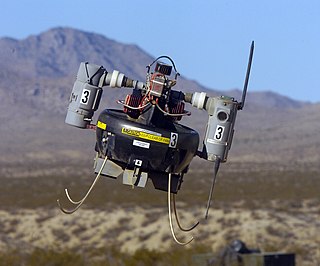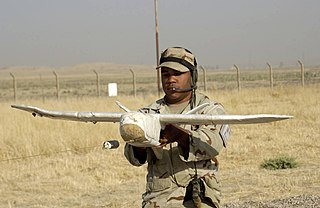External links
| | This article on an unmanned aerial vehicle is a stub. You can help Wikipedia by expanding it. |
| | This military aviation article is a stub. You can help Wikipedia by expanding it. |
The NAL/ADE Black Kite is an unmanned Micro Air Vehicle (MAV) technology demonstrator developed jointly by Aeronautical Development Establishment (ADE) of DRDO and National Aerospace Laboratories (NAL) of CSIRI and supported by private vendors. It is one of the airframe designs being pursued for " National Program on Micro Air Vehicles" (NP-MICAV)
Black Kite is a fixed-wing aerial vehicle having platform shape of Modified Inverse Zimmerman. Its airframe is made of Carbon-fiber-reinforced polymer and Rohacell. It runs on electric battery and is propelled by an AXi2204/54 Brushless Motor APC 7"x6" with a flight endurance of 30 minutes. The Black Kite is constructed with a tractor configuration and has its electric motor mounted with the propeller facing forward.
It carries a miniature daylight video camera as payload which can take video from an altitude of 80–100 m and relays the imagery of ground zero to the Ground control station during its flight. The video and telemetry range is about two km. The machine is remotely radio-controlled. An autopilot has also been provided, if it losses link with the Ground Control Station, it is programmed to return base. There are three versions of Black Kite. The prototypes are currently under the user trials.
| Version | XL | M | S |
|---|---|---|---|
| Size: | Fits in 500mm Sphere | Fits in 325mm Sphere | Fits in 300mm Sphere |
| Wing Span: | 432mm | 316mm | 262mm |
| Wing Area: | 0.126 e6 mm2 | 0.059 e6 mm2 | 0.036 e6 mm2 |
| Chord Length: | 359mm | 245mm | 211mm |
| Aspect Ratio: | 1.48 | 1.69 | 1.906 |

A fixed-wing aircraft is a heavier-than-air flying machine, such as an airplane, which is capable of flight using wings that generate lift caused by the aircraft's forward airspeed and the shape of the wings. Fixed-wing aircraft are distinct from rotary-wing aircraft, and ornithopters. The wings of a fixed-wing aircraft are not necessarily rigid; kites, hang gliders, variable-sweep wing aircraft and airplanes that use wing morphing are all examples of fixed-wing aircraft.

A micro air vehicle (MAV), or micro aerial vehicle, is a class of miniature UAVs that has a size restriction and may be autonomous. Modern craft can be as small as 5 centimeters. Development is driven by commercial, research, government, and military purposes; with insect-sized aircraft reportedly expected in the future. The small craft allows remote observation of hazardous environments inaccessible to ground vehicles. MAVs have been built for hobby purposes, such as aerial robotics contests and aerial photography.
Kite types, kite mooring, and kite applications result in a wide variety of kite control systems. Contemporary manufacturers, kite athletes, kite pilots, scientists, and engineers are expanding the possibilities.

National Aerospace Laboratories (NAL), is India's first largest aerospace firm. It was established by the Council of Scientific and Industrial Research (CSIR) at Delhi in 1959 and its headquarters was later moved to Bangalore in 1960. The firm closely operates with HAL, DRDO and ISRO and has the prime responsibility of developing civilian aircraft in India. The CSIR-NAL mandate is to develop aerospace technologies with strong science content, design and build small and medium-sized civil aircraft, and support all national aerospace programmes.

A radio-controlled aircraft is a small flying machine that is controlled remotely by an operator on the ground using a hand-held radio transmitter. The transmitter communicates with a receiver within the craft that sends signals to servomechanisms (servos) which move the control surfaces based on the position of joysticks on the transmitter. The control surfaces, in turn, affect the orientation of the plane.
MAV may refer to:

A miniature UAV, small UAV (SUAV), or drone is an unmanned aerial vehicle small enough to be man-portable.

The Lockheed Martin Desert Hawk is a miniature UAV used for base perimeter protection. It was designed by Lockheed Martin's Skunk Works for the United States Air Force Force Protection Airborne Surveillance System (FPASS) Program on a quick-reaction contract issued late in the winter of 2002, with the first system delivered in the early summer. It was designed quickly, because the program leveraged technology and design studies developed for the MicroStar MAVs. The program was run by Electronic Systems Center. In 2007, the U.S. Air Force FPASS office switched all of their UAV systems over to the RQ-11B Raven.

Robert C. Michelson is an American engineer and academic widely known for inventing the entomopter, a biologically inspired flapping-winged aerial robot, and for having established the International Aerial Robotics Competition. He has received degrees in electrical engineering from the Virginia Polytechnic Institute and the Georgia Institute of Technology. Michelson's professional career began at the U.S. Naval Research Laboratory where he worked on radar-based ocean surveillance systems. He later became a member of the research faculty at the Georgia Institute of Technology. At the Georgia Tech Research Institute (GTRI) he was involved in full-time research, directing over 30 major research programs.
Integrated Dynamics is a private company in Pakistan that designs, manufactures and exports various types of unmanned aerial vehicles (UAV). ID also provides consultancy and turn-key project commissioning for UAV systems.

The DRDO Nishant is an unmanned aerial vehicle (UAV) developed by India's Aeronautical Development Establishment (ADE), a branch of Defence Research and Development Organisation (DRDO) for the Indian Armed Forces. The Nishant UAV is primarily tasked with intelligence gathering over enemy territory and also for reconnaissance, training, surveillance, target designation, artillery fire correction, damage assessment, ELINT and SIGINT. The UAV has an endurance of four hours and thirty minutes. Nishant has completed development phase and user trials.

The Honeywell RQ-16A T-Hawk is a ducted fan VTOL miniature UAV. Developed by Honeywell, it is suitable for backpack deployment and single-person operation.
The Imperial Eagle is an Indian light-weight mini-unmanned aerial vehicle (UAV) developed by the Aeronautical Development Establishment, National Aerospace Laboratories and supported by private vendors. Its primary users will be the National Security Guard and the military services.
The NAL / ADE Golden Hawk is an unmanned Micro Air Vehicle (MAV) technology demonstrator developed jointly by Aeronautical Development Establishment (ADE) of DRDO and National Aerospace Laboratories (NAL) of CSIR. It based on basic design of Shashank Misra and is one of the airframe designs being pursued for " National Program on Micro Air Vehicles" (NP-MICAV)
The NAL / ADE Pushpak is an unmanned Micro Air Vehicle (MAV) technology demonstrator developed jointly by Aeronautical Development Establishment (ADE) of DRDO and National Aerospace Laboratories (NAL) of CSIRI. It is one of the airframe designs being pursued for "National Program on Micro Air Vehicles" (NP-MICAV)
NAL Slybird is a mini-unmanned aerial vehicle (UAV) developed in India by National Aerospace Laboratories (NAL). Its primary users will be police and the military services.
RY series UAVs are a series of Chinese micro air vehicle (MAV) developed by Beijing LSSA Technology Co., Ltd. . RY series MAV is characterized by utilizing autopilots and GPS, one of the first among Chinese UAVs developed by private firms in China. Although LSSA is actively marketing the RY series UAVs with numerous commercials, not much technical details have been revealed, probably because the company ventured to UAV business in its latest expansion, hence UAV arena is a relatively new area, in comparison to other more established business of the company. LSSA has been traditionally a company providing subsystems, software for flight control and system integration of hardware and software for other UAV manufacturers, and RY series is its first attempt to establish its own brand of UAVs.

The DelFly is a fully controllable camera-equipped flapping wing Micro Air Vehicle or Ornithopter developed at the Micro Air Vehicle Lab of the Delft University of Technology in collaboration with Wageningen University.
Meiya Pico unmanned aerial vehicles are drones developed by Xiamen Meiya Pico Information Technologies Co., Ltd., a company originally formed in 1999, with hardware business mainly in the area of information system / technology and security systems, and software business mainly in the area of supporting its hardware business. Recently, Meiya Pico has expanded its business into unmanned aerial vehicles by integrating commercial off-the-shelf subsystems, as well as integrating software it has developed on its own to these subsystems.
Tongji University UAVs are Chinese UAVs developed by Tongji University, and most of which are experimental UAVs.